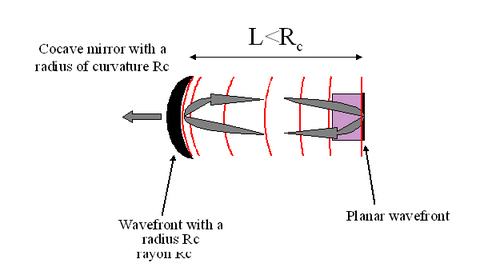Laser : Fundamentals

Choice of the radius of curvature of the mirror and the laser mode in the cavity
The cavity shown in Figure E4 is “planar-concave” composed of a planar mirror placed on a Nd:YAG crystal and a concave output mirror. The radius of curvature of the mirror and the distance between the two mirrors are specifically chosen so that a Gaussian wave can propagate indefinitely in the cavity while keeping the same shape throughout the cavity.
Figure E6 shows the form of this wavefront at several points in the cavity. Its radius of curvature closely follows the shape of the end mirrors: concave on one side and flat on the other. For such a Gaussian wave to exist in a planar-concave cavity, the length of the cavity must be shorter than the radius of curvature of the concave mirror. Then the cavity is said to be stable.
